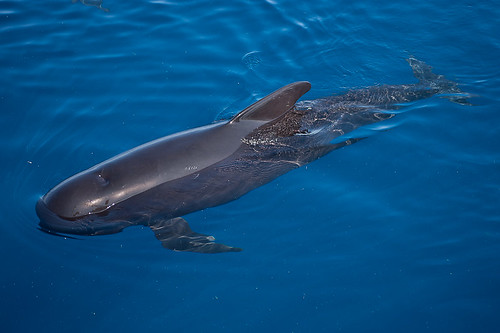Scientific Name: Globicephala melas
Other Names: Pothead Whale, Atlantic Pilot Whale, Longfin Pilot Whale, Caaing Whale
The Long-Finned Pilot Whale remains an abundant species, despite having been hunted quite extensively in times past. It is often confused with the Short-Finned Pilot Whale, but is distinguished by its longer fins, and a different shaped skull.

A pod of Long Finned Pilot Whale under water.

Long Finned Pilot Whale on the surface.
Physical Characteristics.
The Long-Finned Pilot Whale’s body is more slender in its youth than when it is older, when it takes on a more robust form. It is black or very dark grey in colour, with small white patches on the throat and on the belly. Older individuals get a grey patch on their backs, which is called a cape.
The dorsal fin is broad and situated quite far forward on the body, closer to the head. It is low and has a concave trailing edge. The dorsal fins are long and narrow with bends that makes them look like they have an elbow joint. The tail fins have a deep notch in the centre with concave trailing edges and sharp points.
This whale species reaches about four to six metres in length at full size and weighs between 1.8 and 3.5 tonnes at adulthood.
Behaviour
The Long-Finned Pilot Whale travels in pods of between 10 and 50 individuals. Sometimes, this number exceeds hundreds, and even thousands, of individual whales for short periods of time.
They are active animals, and are often observed spyhopping and lobtailing at the ocean’s surface. Although they usually dive to depths of between 30 and 60 metres, they are capable of reaching impressive depths of up to 600 metres.
Where to Find Them
Long-Finned Pilot Whales prefer deep water and are found in the cold temperate and sub-polar waters of the world with the exception of the North Pacific Ocean. There are two specific populations – those in the North Atlantic and those found in a belt across the Southern Hemisphere. Some stay offshore or inshore, while others travel from inshore to offshore.
Diet
On each of their jaws, these whales have between 16 and 24 teeth, making them adept hunters. They feed on fish and squid, with are easy to seize and chew with their teeth.
Threats
The biggest threats to the Long-Finned Pilot Whale are hunting / whaling and fishing nets. Once the whale becomes entangled in a net, it cannot reach the surface of the water for air, and soon drowns.
For more information, please go to: HERE

